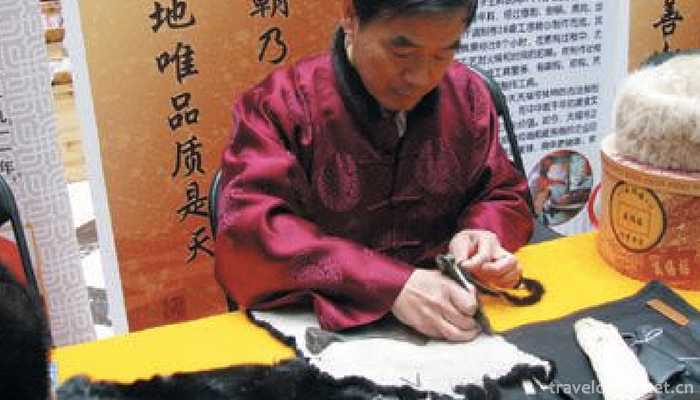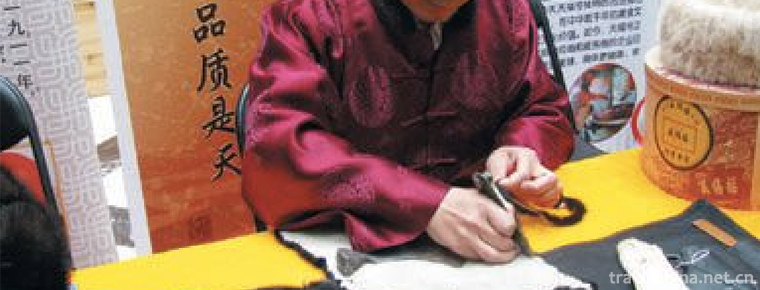Making Skills of Sheng Xifu Leather Cap
Making Skills of Sheng Xifu Leather Cap
Sheng Xifu leather hat making skills, Beijing Dongcheng District, the traditional handmade hat making skills, one of the national intangible cultural heritage.
Shengxifu leather cap production skills need to go through the whole process from matching, picking, blowing, brushing, flat leather, shaving, hand needle sewing to machine sewing, and finally complete a Shengxifu leather cap finished product.
On June 14, 2008, Sheng Xifu leather cap production technology was approved by the State Council of the People's Republic of China and listed in the second batch of national intangible cultural heritage list, project number: _-113.
historical origin
Rise: Rejuvenate National Goods by Machinery Production
Shengjufu Hat Shop, the predecessor of Shengxifu, was founded in Tianjin in the first year of the Republic of China (1911). In 1911, Liu Xisan and his joint venture opened Shengjufu Hat Shop in Shiyi Street, Tianjin. After six years of painstaking operation, Shengxifu Hat Shop was established in the French Concession of Tianjin. "Sheng" takes the meaning of flourishing business, "Xin" and "Fu" from Liu Xisan's large size and nickname.
Liu Xisan is keenly aware that in order to make Sheng Xifu's hat superior to others, he must have advanced technology and equipment, so he spares no expense in introducing Western Hat-Making equipment. In 1919, Sheng Xifu purchased a complete set of straw hat machines from the West for 200,000 silver yuan, set up straw hat factories for self-production and self-sale, and soon opened up a market in Tianjin. A few years later, he sent his third apprentice to Japan to study, master the latest technology, and ensure that the production of four seasons hat has strict process and testing means. By the 1920s and 1930s, Shengxifu had entered its heyday, and its current scale of operation could only be expected.
From Tianjin to Beijing: Admitting Handicraft Skills of Family Workshops
After 1936, the production and processing of leather caps in Shengxifu, Beijing, mainly relied on family workshops. Family workshops operate on a small scale and accept customized and incoming processing work. Li Xinxuan ("Sheng Xifu" the second generation of inheritors) "Henglong Pixing" is one of them. He often works for "Sheng Xifu" and manufactures all kinds of high-grade leather caps by hand. Li Xinxuan's craftsmanship has been traced back to the origin of "Sheng Xifu" leather cap making skills. At that time, there must be many such family workshops, but the name of the family workshops is "Henglong Pixing".
After the founding of New China, "Sheng Xifu" went through the process of public-private joint venture. The "Sheng Xifu" Hat Factory was established at No. 19 Shao Jiuhutong, Wangfujing, which really realized the business model of "front store and back factory". Many of the first workers were absorbed from family workshops. Sheng Xifu of Beijing and Tianjin both use the trademark of "three hats". Beijing Shengxifu experienced the most difficult period in the early 1990s. Wangfujing Street was rebuilt and demolished. Workers left the factory to find a new way out. The hat industry also entered the lowest tide. People's dress fashion changed dramatically. Hats were no longer considered necessary to wear. During the most difficult period of the enterprise, only 18 workers remained in production. Until 1998, Shengxifu reorganized and opened its stores in Wangfujing. In 2000, it was transformed into Beijing Shengxifu Cap Industry Co., Ltd. and its development entered a new era.
Inheritance and Protection
Inheritance value
Shengxifu leather cap manufacturing process is complex, each process requires excellence, its material and fine workmanship is difficult to achieve. This manufacturing process is the technological achievement of Cap-Making masters of past dynasties through long-term accumulation of production experience. These handicraft processes have incomparable advantages in mechanical manufacturing. This technology is not only a simple mechanical work, but also a valuable handicraft technology and a precious historical heritage.
Sheng Xifu's hat making technology is the first in China. It combines the excellent technology of hat making in China and forms a unique production system. The quality of Sheng Xifu's hat is determined by strict process in its later period, so it has a fine appearance and better quality assurance. Sheng Xifu leather cap has become a top-quality product in China's hat industry, which has been affirmed by national leaders for many times. As a symbol of China's hat industry, Sheng Xifu presents to international friends. After entering the 21st century, Sheng Xifu has entered the international market and won people's attention in the international market. This is a big step for Chinese traditional craft to go abroad, and also enables Chinese traditional craft culture to get access to the international market. Certain recognition.
Heritage figures
Li Jinshan, male, was born on January 12, 1955. On May 26, 2009, Li Jinshan was selected as the representative successor of the third batch of national intangible cultural heritage projects and declared in Dongcheng District of Beijing. Project Name: Sheng Xifu leather cap making skills.
protective measures
In 2009, the State-level intangible cultural heritage Shengxifu Leather Cap Production Technology Inheritance Workshop was established. Through in-depth excavation of the history and culture of Chinese crown cap and Centennial hat making technology, Shengxifu history and culture, the material cultural heritage and intangible cultural heritage will be integrated, and Shengxifu Leather Cap production technology will continue to be inherited.
In June 2010, Sheng Xifu China Hat Culture Museum opened. The purpose of the museum is to "trace back the history and civilization of Chinese hat, inherit the traditional hat making techniques and develop hat culture", protect cultural heritage, inherit Sheng Xifu's hat making techniques, and take a new road between tradition and modern times to reproduce the brilliance of Chinese traditional hat culture.
social influence
Important Exhibitions
From September 17 to September 21, 2018, the Commercial Committee of Dongcheng District of Beijing held the Exhibition of Old Brand Skills, in which Sheng Xifu's leather hat making skills were displayed.
Honorary recognition
In 1979, the three-hat hat hat manufactured by Shengxi Fukuo Hat Factory won the award of the Ministry of Light Industry and Tianjin Quality Products.
In 1983, Sheng Xifu leather cap was awarded Tianjin High Quality Product Award and the title of National Minority Goods High Quality Product.


-
1.Xixi National Wetland Park
Xixi National Wetland Park is located in the west of Hangzhou City, Zhejiang Province. It is only 6 kilometers away from Wulin Gate, the main city of Hangzhou, and 5 kilometers away from West Lake.
Time 2018-12-07 -
2.Jinggangshan MountainMt Jinggang
Jinggangshan, National AAAAA Tourist Scenic Spot, National Key Scenic Spot, National Nature Reserve, Chinese Cultural Scenic Spot
Time 2018-12-08 -
3.Guilin Yijiang Margin Scenic Spot
Guilin Yijiang Rim Scenic Spot is situated on the northwest tour line of Guilin with long corridor. It is 32 kilometers away from the urban area (321 National Highway Lingui Wutong Town Section).
Time 2019-01-13 -
4.Taoranting Park
Taoranting Park, located on the northwest side of Taoranqiao in the South Second Ring of Beijing, is a new modern urban garden, which integrates ancient and modern gardening arts and focuses on highli
Time 2019-02-13 -
5.Xijiashan Folk House
Xijiashan Residence, a national key cultural relic protection unit and national AAAA-level tourist attraction, is located in Xijiashan Town, Jiang'an County, Yibin City, Sichuan Province
Time 2019-02-25 -
6.Baxian longevity noodles
Make it with Udonghua noodles. With turtle, old turtle boiled soup, turtle has a nourishing role, old turtle represents longevity. Take shrimp, squid, sea cucumber, black fish balls
Time 2019-03-27 -
7.Pile brocade
Duijin, also known as Shangdang Duijin, is a handicraft hand Duijin is developed on the basis of traditional Chinese painting and embroidery. It is made of silk as the main fabric
Time 2019-04-28 -
8.Leting drum
Music Pavilion Drum is a representative form of traditional music drum book and drum music in northern China. It is widely spread in eastern Hebei, Beijing, Tianjin and northeastern Liaoning, Jilin, H
Time 2019-05-11 -
9.Wool Textile and Rolling Techniques
Flower felt is the most popular among all ethnic handicrafts in Xinjiang, and it has a long history. Felt caps from the 1st to 3rd centuries A.D. are among the cultural relics unearthed at Lop Nur Lou
Time 2019-05-25 -
10.Ceramic microbooks
Ceramic micro-calligraphy is one of the folk skills which perfectly combines Chinese calligraphy art with color porcelain art. It has a long history. Artists not only maintain the traditional style, b
Time 2019-06-18 -
11.Shaoxing opera
Vietnam Opera is the second largest opera in China, known as the second national opera, also known as the "most widely circulated local opera". Some people think that it is the "largest
Time 2019-07-16 -
12.Zhuang Drama
Zhuang Opera, a local traditional drama in Guangxi Zhuang Autonomous Region, is one of the national intangible cultural heritage.
Time 2019-08-16